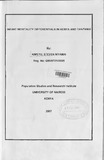| dc.description.abstract | Infant mortality is an important indicator for describing the social and economic
wellbeing of a country. In 2002, almost half of Sub-Saharan African countries
had infant mortality rates greater than 100 per 1000 live births, with Sierra
Leone, Liberia Niger and Angola having the highest. In Kenya infant mortality
is very high and has continued to rise since 1989, that is, from 60 infant deaths
per 1000 live births to 77 in 2003. Kenya Demographic and Health Survey
(KDHS) 2003, records that infant mortality was 77 deaths per 1000 live births
for the most recent five-year period preceding the survey (CBS et al 2004).
Similarly, Tanzania Demographic and Health Survey (TDHS) 2004-5 recorded
68 infant deaths per 1000 live births (NBSD 2005). The above scenario was so
despite more or less similar Gross Domestic Product (GDP). Kenya's GDP
was estimated at 5.8 percent in 2006 while that of Tanzania was estimated at
6.0 percent, in the same period.
The main objective of this study was to establish the determinants and the
differentials of infant mortality in Kenya and Tanzania, specifically the socioeconomic
determinants of in~ant mortality in Kenya while controlling for biodemographic
and socio-cultural factors, as well as to establish the biodemographic
determinants of infant mortality in Kenya and Tanzania while
controlling for socio-economic and socio-cultural factors. The data used to
inform this study finding was drawn from the 2003 KDHS and the 2004-5
TDHS.
Descriptive statistics reveal that most of the variables were highly associated
with infant mortality in both countries. Mother's age at birth, birth order and
preceding birth interval and mother's level of education had strong association
with the dependent variable. Marital status, wealth index and religion were
weakly associated with infant mortality, in both countries.
Multivariate analyses reveal that birth order and preceding birth interval, as
well as mother's level of education, were highly significant predictors of infant
mortality in both countries. Mother's level of education was significant at 95
and 99 percent confidence level in Kenya and Tanzania, respectively, at the
secondary+ category, after controlling for bio-demographic and socio-cultural
factors. Birth order and preceding birth interval, which were combined to form
a composite variable due to their collinear relationship, had a strong effect on
the dependent variables. In both countries, birth order 4+ and preceding birth
interval less than 24 months were Sigficant at percent confidence level,
after the controls. In Kenya, birth order 2 t03 and preceding birth interval <24
months were highly significant while in Tanzania, these category had no
association with infant mortality, even after controlling for socio-economic and
socio-cultural factors.
When bio-demographic and socio-cultural factors were controlled for, odds
ratios for socio-economic factors did not show much difference in both
countries. Type of place of residence, and particularly the rural category in
Kenya, changed slightly from the previous results prior to the control. Those
variables that were significant at the multivariate level remained so, even after
controlling for bio-demographic factors.
The study recommends that there is a need for mother's education to be
revamped since it has an important link with infant mortality. This will not only
bequeath mothers with sound methods of bringing up their infants but will also
push up the mean at marriage, hence minimize adolescent fertility. Family
planning programmes where mothers can be educated on the importance of
family planning, and particularly spacing of births, are also recommended. The
study also recommends further research to establish what factors account for
the differentials in infant mortality between and within the two countries. | en |

